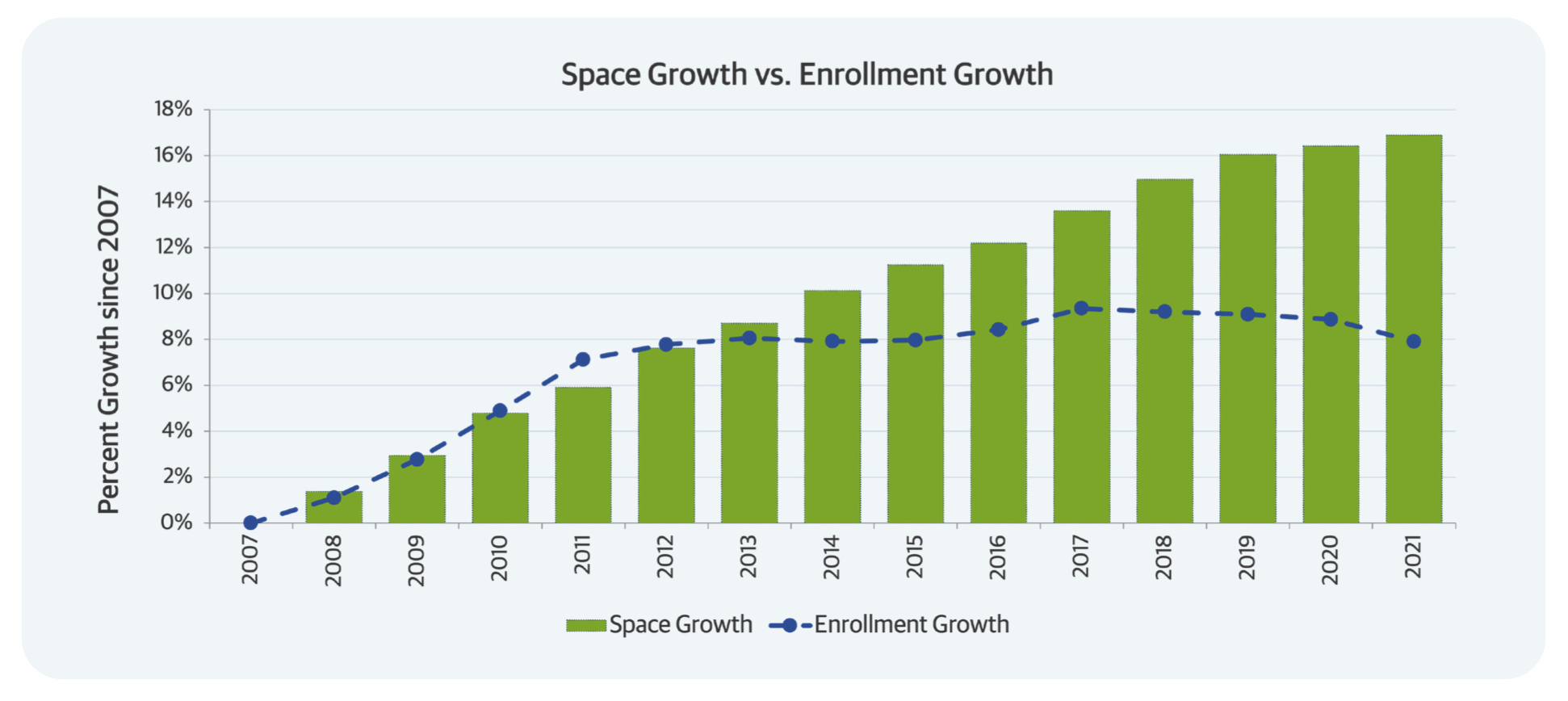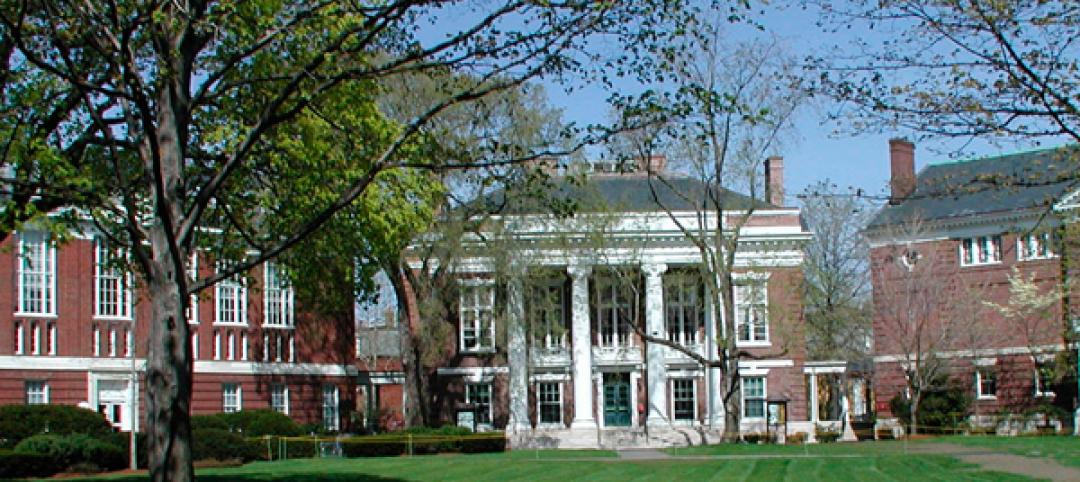Gordian released the 9th edition of the State of Facilities in Higher Education report, which confirms a growing backlog of capital needs and reveals a downturn in operating budgets. Preliminary fiscal year 2021 data shows a year-over-year investment reduction of 19 percent, as major capital projects were slowed or halted, and recurring stewardship expenditures dipped further.
“Across higher education, focused facilities stewardship and capital planning are more critical than ever. The findings from this year’s report further invigorate our mission to help institutions prioritize investments and drive meaningful outcomes within their communities,” says Mark Schiff, President of Gordian.
Throughout the report, Gordian’s database research and its expert insights affirm the following trends that are shifting the higher education landscape:
- Preliminary data warns that the facilities investment shortfall to anticipated demands is approaching 40 percent, accelerating the deferral of projects necessary to steward the campus.
- Gordian’s database shows an average need of $105/GSF at the end of FY20.
- 30 percent of buildings in the Gordian database are in the 10-25-year age group, and the major systems of many of them will soon reach the end of their lives. A convergence of anticipated lifecycle needs for a large portfolio of campus facilities and the well-documented enrollment cliff on the horizon is expected to bear down on higher ed over the next 10-15 years.
- Operating budgets have plunged 9 percent since FY19, and preliminary data for FY21 shows an average workforce reduction of 8 percent.
- Survey results through a partnership with APPA revealed a silver lining — 56 percent of facilities leaders indicated they have greater influence on campus since the pandemic.
This year, data from Gordian’s database of 52,000+ higher ed facilities representing about 300 campuses across North America shows the continuation of familiar trends and some expected changes in response to the pandemic environment. To complement our facilities data with perspectives from the frontline, we partnered with APPA to survey nearly 700 facilities leaders concerning the current pressures they are under and captured the responses in this report.

“Facilities leaders continue to talk about the extent to which their voice has been heard and continues to be heard,” said Pete Zuraw, Vice President of Market Strategy and Development for Gordian. “We want to keep championing your use of that voice to make a difference on your campuses.”
Facilities strategies are at the forefront of the industry’s race to confront its greatest challenge in generations. The report also points to successful case studies and solution frameworks to help institutions plan coherently, leverage technology and invest creatively. These examples and best practices can be fundamental to helping institutions unified around change adapt to today’s problems and create a richer and more viable future.
Download the 9th edition of the State of Facilities in Higher Education report (short registration required).
Related Stories
| Aug 26, 2013
13 must-attend continuing education sessions at BUILDINGChicago
Building Design+Construction's new conference and expo, BUILDINGChicago, kicks off in two weeks. The three-day event will feature more than 65 AIA CES and GBCI accredited sessions, on everything from building information modeling and post-occupancy evaluations to net-zero projects and LEED training. Here are 13 sessions I'm planning to attend.
| Aug 22, 2013
Energy-efficient glazing technology [AIA Course]
This course discuses the latest technological advances in glazing, which make possible ever more efficient enclosures with ever greater glazed area.
| Aug 14, 2013
Five projects receive 2013 Educational Facility Design Excellence Award
The American Institute of Architects (AIA) Committee on Architecture for Education (CAE) has selected five educational and cultural facilities for this year’s CAE Educational Facility Design Awards.
| Aug 14, 2013
Green Building Report [2013 Giants 300 Report]
Building Design+Construction's rankings of the nation's largest green design and construction firms.
| Aug 8, 2013
Energy research animates science sector [2013 Giants 300 Report]
After an era of biology-oriented spending—largely driven by Big Pharma and government concerns about bioterrorism—climate change is reshaping priorities in science and technology construction.
| Aug 8, 2013
Top Science and Technology Sector Engineering Firms [2013 Giants 300 Report]
Affiliated Engineers, Middough, URS top Building Design+Construction's 2013 ranking of the largest science and technology sector engineering and engineering/architecture firms in the U.S.
| Aug 8, 2013
Top Science and Technology Sector Architecture Firms [2013 Giants 300 Report]
HDR, Perkins+Will, HOK top Building Design+Construction's 2013 ranking of the largest science and technology sector architecture and architecture/engineering firms in the U.S.
| Aug 8, 2013
Top Science and Technology Sector Construction Firms [2013 Giants 300 Report]
Skanska, DPR, Suffolk top Building Design+Construction's 2013 ranking of the largest science and technology sector contractors and construction management firms in the U.S.
| Aug 6, 2013
Renovation of Radcliffe Institute for Advanced Study yields oldest LEED-certified building in U.S.
The Radcliffe Institute for Advanced Study recently achieved LEED-NC v3 Gold certification for its renovation of the historic Fay House, making it the oldest LEED-certified building in the United States.
| Jul 31, 2013
15 innovations impacting higher education
Colleges must become more nimble, entrepreneurial, student-focused, and accountable for what students learn, according to Steven Mintz, Executive Director of the University of Texas system’s Institute for Transformational Learning. Mintz offers 15 innovations in higher education.

















